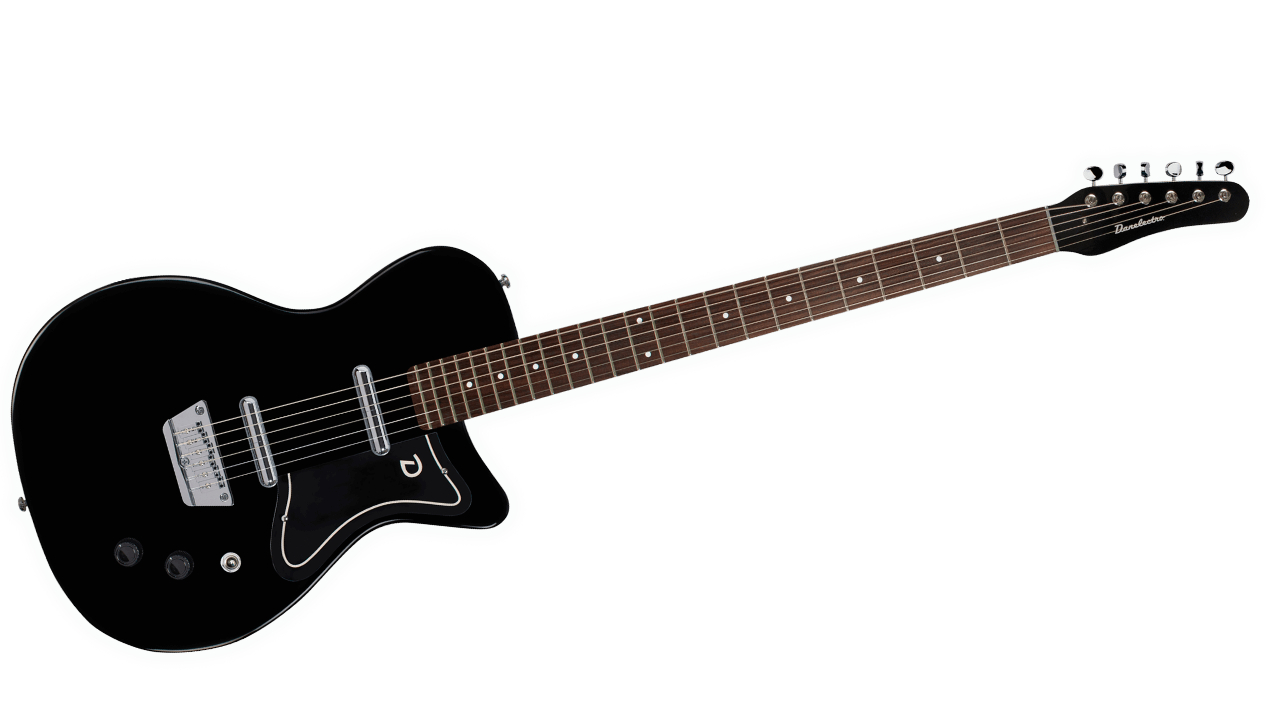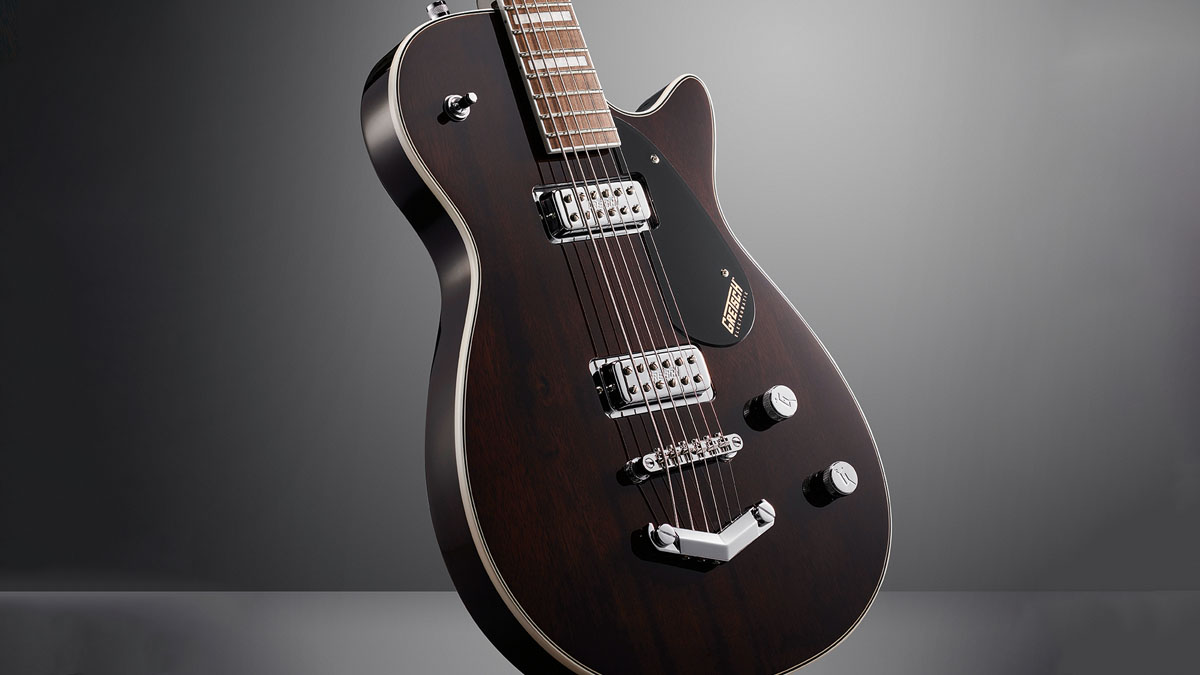MusicRadar Verdict
The Jet with the big long neck has the big low tones to go with it and presents a supremely versatile and approachable platform for the baritone enthusiast and neophyte alike.
Pros
- +
Classy old-school looks and lots of vibe.
- +
Crowd-pleasing baritone sounds.
- +
A playable and fun guitar.
- +
Nice price.
Cons
- -
Some might prefer the Bigsby-equipped version.
- -
Would be interesting to hear one with Dynasonic pickups.
MusicRadar's got your back
Gretsch Electromatic G5260 Jet Baritone: What is it?
As baritone guitars go, the Gretsch Electromatic G5260 Jet Baritone is straight out of the old-school, assuming the classic single-cut shape, stretching the format out to a 29.75” scale length, and perhaps giving guitar players a newfound empathy for their bass-playing colleagues.
The scale length is not the only thing that distinguishes it from the other Jets in the Gretsch hangar. Where the current Electromatic Jets are fitted with Black Top Broad’Tron pickups, here we have a pair of Gretsch-branded mini-humbuckers. The control setup is pared down to master volume and tone dials, with a three-way pickup selector switch on the shoulder.
The neck on the G5260 joins the body via a four-bolt joint, as opposed to the lower set necks of the G5220. This is a solid mahogany body, whereas the G5220 has a newly upgraded chambered mahogany body with a maple top.
There is no mistaking the lineage. The apple has not fallen too far from the tree – it’s a Jet for sure. A contemporary one, too, for both the G5260 and its standard-tuned counterpart have Thin U profile necks – this maple, the G5220 mahogany – giving you just enough wood to hold onto, but not so much that you feel like you are wrestling a baseball bat. Like contemporary Electromatic models, it is also presented at a relatively friendly price, with street prices offering plenty of change from 500 bucks.

Once upon a time a guitar like this would have caused confusion. When the baritones of yesteryear with such scale lengths and designs hit the market, they’d be described as six-string bass guitars, but despite the G2560’s extension into lower registers, arriving tuned to B, it is not going to put the Precision Bass out of commission.
What it can do is complement it, and of the other stringed instruments around it. The G5260 also demonstrates that low tunings are not the sole preserve of the metal guitar player, but rather can be deployed in all different genres and playing styles.
Gretsch offers the Jet Baritone with the option of a Bigsby B50 vibrato or, as in the case of our review model here, a V stop-tail, which looks distinctly automotive and works in tandem with an anchored Adjusto-Matic bridge.
Want all the hottest music and gear news, reviews, deals, features and more, direct to your inbox? Sign up here.
Gretsch Electromatic G5260 Jet Baritone: Performance and verdict
There is a little acclimatisation for players of a regular electric guitar tuned EADGBE that needs to go on before you can really get to grips with the G5260. That’s a lot of neck. Those who are approaching it from a regular bass, however, with a 34” scale, might conversely find it approachable and compact.
But with a little time, this is a guitar that will meet all comers somewhere in the middle. The baritone might still be a niche platform for many but Gretsch is doing its utmost to popularise it. The fit and finish is impressive. There was a little pop on the output jack on this model, but that is not the sort of thing to unduly concern you at the store.

The fretwork and factory setup are exemplary, and the tuning stability is to be applauded.
Starting with a clean tone, on the bridge pickup, and there’s a snarl to the voice, enough trouble to send the upper lip into a curl, but depth, lots of depth.
At the neck pickup, those cleans have a woody, piano-esque character, retaining the clarity but adding width and warmth. Apply chorus and delay for haunting chords. Apply spring reverb and slapback and you have a low-riding electric tone for rock ’n’ roll, easily augmented by the remainder of your pedalboard for shoegaze, indie and whatever.

• Danelectro '56 Baritone
The '56 or any of Dano's other baritone guitars are well worth checking out for players whose tastes skew retro, and who might want some low-end twang for spaghetti western and rockabilly fun times. Note: Dano has just reissued the Baritone Longhorn, which would be another interesting contender.
• Hagstrom Viking Deluxe Baritone
A quality ES-style baritone, the Viking Deluxe combines Hagstrom's superb playability with an interesting pickup combo comprising a P-90-style P-Urified single coil at the neck, and a humbucker at the bridge.
This is a guitar that takes pedals nicely.
Gretsch makes some bold claims of these mini-buckers, maintaining that they hold together with clarity and body no matter where you set the gain on your guitar amp or whatever drive pedal is active in the signal path – and they make good on this, up to a point.
That bridge pickup is a lot of fun with high-gain fuzz, or a generous helping of drive. For contemporary high-gain baritone metal guitar, you might want to look elsewhere, to those equipped with high-output active humbuckers.
Similarly, those who are turned on to the musical potential of the baritone by Duane Eddy might still find themselves hankering for “tic-tac twang”, and would be advised to seek out – somehow – his signature G6120TB-DE six-string bass, which was released by Gretsch in 2018. Or maybe looking to a Dano, and the skinnier tone profile of its lipstick pickups.
But you can make the case that this G5260 is more versatile than those that preceded it. It’s easy to fret chords, to play riffs and leads alike. Upper register chords have the shimmer they need; those low-down open chords just sound so deep. You might find yourself simply transposing your style down to baritone tuning, hearing it anew, yet this is an instrument that invites fresh thinking on the instrument.
MusicRadar verdict: The Jet with the big long neck has the big low tones to go with it, and presents a supremely versatile and approachable platform for the baritone enthusiast and neophyte alike.
Gretsch Electromatic G5260 Jet Baritone: Hands-on demos
Alamo Music Center
Cream City Music
Gretsch Electromatic G5260 Jet Baritone: Specifications

- BODY: Mahogany
- NECK: Maple, bolt-on
- SCALE: 29.75”
- FINGERBOARD: Indian laurel with Big Block pearloid inlay
- FRETS: 22, medium jumbo
- ELECTRONICS: 2x Gretsch mini-humbuckers
- CONTROLS: Volume, tone, three-way toggle
- HARDWARE: Sealed tuners, V-Stoptail, chrome
- LEFT-HANDED: No
- FINISH: Imperial Stain [as reviewed], London Grey Metallic, Bristol Fog, Jade Grey Metallic
- CONTACT: Gretsch
MusicRadar is the number one website for music-makers of all kinds, be they guitarists, drummers, keyboard players, DJs or producers...
- GEAR: We help musicians find the best gear with top-ranking gear round-ups and high-quality, authoritative reviews by a wide team of highly experienced experts.
- TIPS: We also provide tuition, from bite-sized tips to advanced work-outs and guidance from recognised musicians and stars.
- STARS: We talk to musicians and stars about their creative processes, and the nuts and bolts of their gear and technique. We give fans an insight into the craft of music-making that no other music website can.

